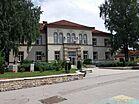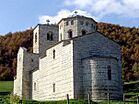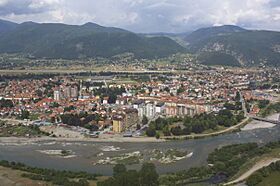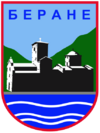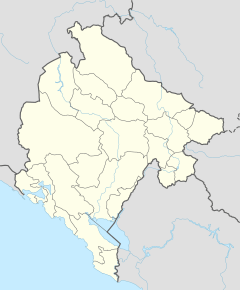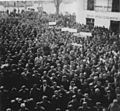Berane facts for kids
Quick facts for kids
Berane
Беране
|
|||
|---|---|---|---|
|
Town and municipality
|
|||
|
Clockwise, from top: Berane town hall, Đurđevi stupovi monastery, Grammar School, Main square, Panorama of Berane
|
|||
|
|||
| Country | |||
| Region | Northern Montenegro | ||
| Municipality | |||
| Founded | 1862 | ||
| Settlements | 66 | ||
| Area | |||
| • Town and municipality | 496 km2 (192 sq mi) | ||
| Population | |||
| • Rank | 8th in Montenegro | ||
| • Density | 49/km2 (130/sq mi) | ||
| • Urban | 9,923 |
||
| • Rural | 15,239 |
||
| • Municipality | 25,162 |
||
| Time zone | UTC+1 (CET) | ||
| • Summer (DST) | UTC+2 (CEST) | ||
| Postal code |
84300
|
||
| Area code | +382 51 | ||
| ISO 3166-2 code | ME-03 | ||
| Car plates | BA | ||
| Climate | Cfb | ||
Berane (Cyrillic: Беране) is a town in Montenegro, located in the northern part of the country. It sits on the Lim river. From 1949 to 1992, the town was called Ivangrad (Cyrillic: Иванград). This name honored Ivan Milutinović, a national hero.
In 2023, Berane had a population of 9,923 people. The wider area of its municipality had 25,162 residents. Berane is an important center for education, medicine, religion, and sports. Many successful people have come from this town.
Contents
History of Berane
In the Middle Ages, the area around Berane was known as Budimlja. It was a very important place for religion, politics, and trade in Medieval Serbia. In 1219, Saint Sava, the first Serbian archbishop, started one of the first Serbian churches here.
The Đurđevi stupovi Monastery was built in the late 1100s. Many monasteries and churches in this area show the rich religious life of the Serbs. Another important monastery, Šudikovo, was destroyed by the Turks in 1738.
The area of Berane was part of the Medieval Serbian state until 1455. That year, the Turks took control of the city of Bihor and Budimlja.
During the First Serbian Uprising (1804), people in this area rebelled against the Turks. Mojsije Zečević, a leader from the Đurđevi stupovi Monastery, played a key role. He was a close friend of Petar I Petrović-Njegoš and Petar II Petrović-Njegoš, who were important leaders of Montenegro.
Fights against the Turks continued until the area was finally freed. Major battles happened between 1825 and 1862. The most famous was the Rudes battle on April 7, 1862, where Serbian and Montenegrin rebels won. Berane was finally freed from the Turks in 1912 and became part of Montenegro.
During World War II, there was a civil war in the region. After the war, from 1949 to 1992, Berane was called Ivangrad. It grew into a major industrial center in Montenegro. However, the town's economy suffered greatly in the late 1980s when Yugoslavia faced economic problems. Even though its original name was brought back in 1992, the town's economy struggled for many years.
Culture and Education
The Serbian Orthodox Church and its monasteries, like Šudikova and Đurđevi stupovi, have greatly influenced the culture of this area. Later, schools and other cultural places took on this role.
The Berane Gymnasium (a type of high school), founded in 1913, was very important. Many famous artists and scientists studied there.
Today, cultural institutions in Berane include the Cultural Centre, which has a library. There is also the Polimski Museum, which has a large collection of old and valuable items. The house of Duke Gavro Vuković, a famous lawyer and writer, has been rebuilt for cultural events. Berane also has a school for music and several amateur art clubs.
There are 13 elementary schools, four high schools, and one music school in Berane. The town also has four colleges: a Faculty of Management in Transport and Communications, a Faculty of Teacher-training, a Higher Medical School, and a program for Applied Computer Engineering. Many well-known scientists have come from Berane, even though it doesn't have a special science institution.
Economy and Sports
The municipality of Berane is one of the less wealthy areas in Montenegro. Many factories and businesses closed in the last 15 years. This happened because of the economic problems that affected former Yugoslavia. In the past, many people moved from farms to the town for factory jobs. But when the factories closed, many people faced tough times.
Recently, many small private businesses have started, mostly in shops and restaurants. The total number of people working in the municipality is about 3,000. However, the economy is slowly improving. A coal mine has reopened, and new commercial buildings are being built. More people are moving back to the town.
Berane is connected to the rest of Montenegro by two-lane roads. Bijelo Polje is 35 kilometers away. From there, you can take a train or road to Podgorica and the coast, or to Serbia. You can also reach Serbia by going east through Rožaje. Berane is also on the route of the future Bar-Boljare motorway.
Berane has an airport, but it hasn't been used for regular flights since the 1980s. There are plans to open it again for regional flights. Podgorica Airport is about 150 kilometers away and has flights to major European cities.
Berane has good sports facilities. The most successful sports teams are the handball club Berane and the table tennis club Budim. There is also the football club Berane, a basketball club, a boxing club, an athletic club, and a tennis club. The Sports Centre has many different sports areas. The City Stadium can hold 11,000 people, making it the second largest stadium in Montenegro. A new city hall is also being built next to the stadium.
People and Population
Berane is the main town of Berane Municipality. In 2023, the municipality had 25,162 people, and the town itself had 9,923 people.
Here's how the population of Berane town has changed over the years:
| Historical population | ||
|---|---|---|
| Year | Pop. | ±% |
| 1948 | 3,701 | — |
| 1953 | 4,513 | +21.9% |
| 1961 | 6,969 | +54.4% |
| 1971 | 11,164 | +60.2% |
| 1981 | 12,720 | +13.9% |
| 1991 | 12,267 | −3.6% |
| 2003 | 11,776 | −4.0% |
| 2011 | 11,073 | −6.0% |
| 2023 | 9,923 | −10.4% |
Ethnic groups (2011 census)
| Ethnicity | Number | Percentage |
|---|---|---|
| Serbs | 4,779 | 43.15% |
| Montenegrins | 3,476 | 31.39% |
| Bosniaks | 1,095 | 9.88% |
| ethnic Muslims | 977 | 8.82% |
| Albanians | 45 | 0.4% |
| Croats | 22 | 0.19% |
| Romani | 10 | 0.09% |
| Other | 39 | 0.35% |
| not declared | 400 | 3.61% |
| Total | 11,073 | 100% |
Languages spoken (2011 census)
| Languages | Number | Percentage |
|---|---|---|
| Serbian | 6,314 | 57.02% |
| Montenegrin | 3,880 | 35.04% |
| Bosnian | 304 | 2.74% |
| Albanian | 42 | 0.37% |
| Croatian | 7 | 0.06% |
| Other | 46 | 0.41% |
| not declared | 346 | 3.12% |
| Total | 11,073 | 100% |
Religions (2011 census)
| Religion | Number | Percentage |
|---|---|---|
| Eastern Orthodox | 7,867 | 71.04% |
| Islam | 2,795 | 25.24% |
| Catholicism | 37 | 0.33% |
| Atheism | 46 | 0.41% |
| Other | 76 | 0.68% |
| not declared | 230 | 2.07 |
| Total | 11,079 | 100% |
Climate
Berane has a climate with warm summers and cold winters. Here are some facts about the weather:
| Climate data for Berane (1961–1990, extremes 1950–present) | |||||||||||||
|---|---|---|---|---|---|---|---|---|---|---|---|---|---|
| Month | Jan | Feb | Mar | Apr | May | Jun | Jul | Aug | Sep | Oct | Nov | Dec | Year |
| Record high °C (°F) | 18.8 (65.8) |
24.1 (75.4) |
26.5 (79.7) |
31.6 (88.9) |
33.9 (93.0) |
35.2 (95.4) |
38.4 (101.1) |
40.4 (104.7) |
36.8 (98.2) |
32.3 (90.1) |
24.1 (75.4) |
20.2 (68.4) |
40.4 (104.7) |
| Mean daily maximum °C (°F) | 2.7 (36.9) |
5.9 (42.6) |
10.6 (51.1) |
15.2 (59.4) |
20.4 (68.7) |
23.3 (73.9) |
25.9 (78.6) |
26.1 (79.0) |
22.4 (72.3) |
17.2 (63.0) |
10.2 (50.4) |
3.4 (38.1) |
15.3 (59.5) |
| Daily mean °C (°F) | −2.0 (28.4) |
0.7 (33.3) |
4.5 (40.1) |
8.7 (47.7) |
13.4 (56.1) |
16.4 (61.5) |
18.3 (64.9) |
17.7 (63.9) |
14.0 (57.2) |
9.2 (48.6) |
4.3 (39.7) |
−0.5 (31.1) |
8.7 (47.7) |
| Mean daily minimum °C (°F) | −5.9 (21.4) |
−3.9 (25.0) |
−0.9 (30.4) |
2.7 (36.9) |
6.4 (43.5) |
9.5 (49.1) |
10.9 (51.6) |
10.3 (50.5) |
7.5 (45.5) |
3.4 (38.1) |
0.0 (32.0) |
−4.2 (24.4) |
3.0 (37.4) |
| Record low °C (°F) | −28.3 (−18.9) |
−26 (−15) |
−18.6 (−1.5) |
−9.2 (15.4) |
−4.2 (24.4) |
0.2 (32.4) |
1.2 (34.2) |
2.2 (36.0) |
−6.1 (21.0) |
−7.7 (18.1) |
−19.8 (−3.6) |
−22.7 (−8.9) |
−28.3 (−18.9) |
| Average precipitation mm (inches) | 82.7 (3.26) |
65.5 (2.58) |
63.1 (2.48) |
81.9 (3.22) |
70.9 (2.79) |
71.6 (2.82) |
60.5 (2.38) |
60.6 (2.39) |
66.3 (2.61) |
74.9 (2.95) |
114.9 (4.52) |
100.4 (3.95) |
913.3 (35.95) |
| Average precipitation days (≥ 0.1 mm) | 12 | 11 | 12 | 13 | 13 | 13 | 10 | 9 | 9 | 9 | 14 | 14 | 139 |
| Average relative humidity (%) | 83 | 78 | 73 | 70 | 70 | 71 | 69 | 70 | 76 | 78 | 81 | 85 | 75 |
| Source: Hydrological and Meteorological Service of Montenegro | |||||||||||||
Sister Cities
Berane has special friendships with other cities around the world. These are called "twin towns" or "sister cities":
 Belgrade, Serbia
Belgrade, Serbia Çiğli, Turkey
Çiğli, Turkey Čukarica, Belgrade; Serbia
Čukarica, Belgrade; Serbia Dudelange, Luxembourg
Dudelange, Luxembourg Esch-sur-Alzette, Luxembourg
Esch-sur-Alzette, Luxembourg Karaisalı, Turkey
Karaisalı, Turkey Kostroma, Russia
Kostroma, Russia Peja, Kosovo
Peja, Kosovo Staro Nagoričane, North Macedonia
Staro Nagoričane, North Macedonia Subotica, Serbia
Subotica, Serbia Teramo, Italy
Teramo, Italy Vrnjačka Banja, Serbia
Vrnjačka Banja, Serbia Zavidovići, Bosnia and Herzegovina
Zavidovići, Bosnia and Herzegovina
Famous People
Berane has been home to many successful people in arts, sports, education, and other fields:
Artists
- Dejan Čukić, actor
- Boban Rajović, singer
- Ljubomir Bandović, actor
- Zvonko Lepetić, actor
Athletes
- Dragoslav Jevrić, football goalkeeper
- Stefan Babović, football player
- Ivan Đurković, handball player
- Sonja Barjaktarović, handball goalkeeper
- Milonja Đukić, football player
- Igor Vušurović, volleyball player
- Mijajlo Marsenić, handball player
- Maja Savić, handball player
- Zoran Bojović, football player
- Vladan Savić, football player
- Dragan Popović, football coach
- Aleksandar Šćekić, football player
- Nemanja Šćekić, football player
- Siniša Dobrašinović, football player
- Elsad Zverotić, football player
Political, Educational, and Historical Figures
- Jevstatije I, Serbian Archbishop
- Žarko Obradović, politician
- Momčilo Cemović, politician
- Gavro Vuković, senator
- Fahrudin Radončić, politician
- Selmo Cikotić, politician
- Šerbo Rastoder, historian
- Miomir Dašić, historian
Others and Related People
- Milovan Đilas, politician
- Pavle Đurišić, officer
- Radovan Zogović, poet
- Dragoslav Šekularac, football player
- Jelena Janković, tennis player
- Dragan Nikolić, actor
- Aleksandar Šapić, water polo player
- Miodrag Bulatović, novelist
Gallery
See also
 In Spanish: Berane para niños
In Spanish: Berane para niños


